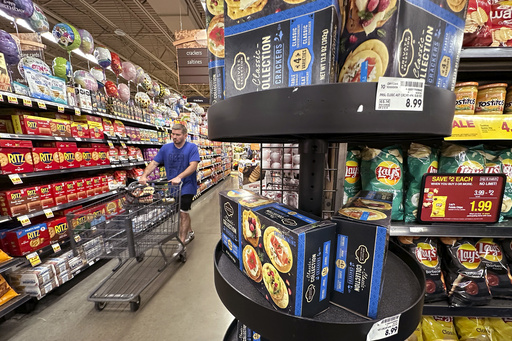
WASHINGTON — For the first time in seven months, there are indications that annual inflation could have increased in October, suggesting that the trend of gradually slowing price rises might be coming to a halt after years of decline.
Economists surveyed by a data analytics firm estimate that consumer prices rose by 2.6% compared to the previous year, up from a 2.4% increase in September. Month over month, it is projected that prices rose by 0.2% from September to October, matching the prior month’s increase.
Core prices, which exclude the more volatile food and energy sectors, are expected to have increased by 3.3% year-on-year, remaining stable from the previous month. Month-to-month, core prices are anticipated to have risen by 0.3%, maintaining this pace for the third consecutive month. If this trend persists, it could surpass the Federal Reserve’s target for inflation, which is set at 2%.
An increase in inflation could raise alarms in financial markets about the potential slowing of progress in controlling price rises. This situation may lead the Federal Reserve to reconsider its signals about potential interest rate cuts planned for December and into the following year.
Yet, many experts hold the belief that inflation will eventually start to decline again. Having reached a peak of 9.1% in 2022, consumer inflation has consistently decreased, but it now remains about 20% higher than it was three years ago. The surge in prices has impacted public perception of the economy and the administration’s economic management, influencing Vice President Kamala Harris’ recent electoral defeat.
Donald Trump’s recent electoral success creates a climate of unpredictability regarding inflation and the Federal Reserve’s potential responses to any resurgence. Trump has committed to combating inflation, primarily by increasing oil and gas production. However, many economists caution that certain proposals he has suggested, particularly significant increases in tariffs on imports and mass deportation strategies, could worsen inflation if enacted.
In the aftermath of Trump’s election, stock market values rose due to optimism that his proposed tax cuts and deregulation would stimulate the economy and increase corporate earnings. Conversely, bond yields also experienced a rise, likely fueled by concerns that inflation could remain high or worsen.
Additionally, economic growth has outpaced many economists’ initial expectations this year, with advancements nearing a 3% annual rate over the last six months. This growth has been largely driven by robust consumer spending, particularly among individuals with higher incomes.
“Proposals like tax cuts and tariffs could significantly influence inflation, expectations of inflation, and economic growth,” noted a prominent strategist at a financial management firm. “Due to uncertainties surrounding tax and trade policies, as well as persistent inflationary pressures and economic robustness, the Fed may approach future rate cuts with caution.”
An increase in used-car prices is believed to have contributed to last month’s overall inflation increase, along with rising airfare prices.
On the other hand, there are indications that clothing prices have dropped, as well as costs for groceries, gasoline, and other energy products.
During a press conference last week, Federal Reserve Chair Powell expressed his belief that inflation was still on track to reach the central bank’s 2% target, albeit in a gradual and uneven manner.
“We view the overall trend as consistent with inflation continuing to decline slowly over the next couple of years, settling around the 2% mark,” Powell stated. “A couple of strong or weak data months won’t notably alter the existing pattern at this stage of the process.”
Powell also pointed out that most contributing factors to inflationary pressure appear to be easing, indicating that significant price hikes are unlikely in the near future. While wages continue to grow and have outstripped price increases for the last 18 months, they are not rising quickly enough to drive inflation.
A recent survey from the Federal Reserve Bank of New York highlighted that consumers expect prices to only rise by 2.9% over the next year, marking the lowest expectation in almost four years. Such decreases in inflation expectations are critical, as they reduce the likelihood of consumers acting in ways that could further inflate prices, such as rushing to make purchases or demanding higher wages.
Another potential benefit for consumers may come from a cooling rental market. Nationally, average apartment rents are reportedly not rising significantly, with a real estate brokerage reporting only a 0.2% year-on-year increase in median rent as of October, reaching $1,619, though this figure pertains to new leases only.
The government’s broader assessment of rents shows a faster upward trend since it accounts for existing rental agreements. Many landlords are still adjusting monthly rent charges to reflect the higher costs associated with new leases formed in the past three years.
